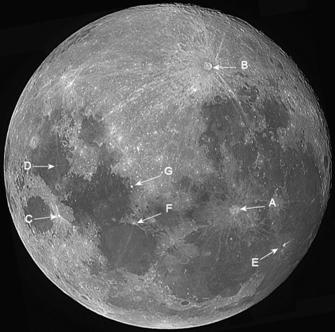Full Moon = No Shadows
Jack Kramer
Sometimes a clear night also offers up a full moon. That being the case, I've made the best of it. When the moon is full, or nearly so, there are no shadows to give depth and definition to surface features. Thus, in order to be seen, a feature has to be either particularly reflective (i.e.: bright) or reflect less light than its surroundings. It is at this time that such features stand out best even in a small telescope. The brightest objects tend to be the youngest, with highly reflective excavated material. The darkest are lava-filled maria and craters. A good lunar atlas is essential and if you don't already have one, I highly recommend the free program Virtual Moon Atlas, available for download at: http://ap-i.net/avl/en/start
First of all, I don't feel it's necessary to use so-called "moon filters" (neutral density) or variable polarizing filters to dim the light of the moon. Serious lunar observers tend to avoid filters because they diminish the ability to see minute details. Even a full moon is no brighter than a daytime landscape - the moon seems so bright simply because of contrast with the dark nighttime sky. And obviously, if you're observing a bright moon there's no night vision to protect. Higher magnification also reduces the apparent brightness and once our eyes are accustomed to the level of illumination, details become more visible. If you have a binoviewer, using both eyes makes the brightness less pronounced, plus it improves the ability to see detail and gives the feel of actually cruising over the moon in a space capsule.
I've enhanced contrast on the image of the moon here in order to make the features more apparent, but in reality the contrast levels are somewhat lower. The arrows point to referenced objects, with alpha characters as keys.
Some of the most obvious features on a full moon are rays emanating from craters. The bright ejecta forming the rays take different shapes largely based on the force and trajectory of the impacting body. Yet there is still some uncertainty about just why certain rays look as they do. Compare the two large, young craters Copernicus (A) and Tycho (B). Rays from Tycho are straight and long, stretching far over the lunar surface. But those emanating from Copernicus are shorter and sinuous, suggesting that the material was lofted high and scattered around somewhat. Proclus (C) has a very bright fan-shaped ray pattern that suggests a particularly forceful impact at an oblique angle. Messier A (D) is an oval crater with two unique parallel rays. Next to it is Messier, which has an even more pronounced oval shape. You should be able to detect the fainter rays from Messier extending at right angles to those from Messier A. Experiments have shown that Messier resulted from a very shallow angle of impact and part of the impacting body ricocheted forward, producing Messier A.

A view of the full moon will surely draw your attention to the crater Aristarchus (E). With a reflectivity around 18%, it's the brightest object on the lunar surface. (The average reflectivity of the moon is only about 7%.) In fact, according to the author T. W. Webb, Aristarchus can be seen with the naked eye at the time of full moon. I guess that would be a test of really good eyesight! It has a sinuous ray pattern with one very bright, short ray extending along its neighboring crater Herodotus.
You'll note under full moon illumination that the walls of some craters appear particularly bright while the crater floors are darker. Again, that's due to the "fresh" nature of the material thrown up on impact. One such example is the crater Menelaus (F) which appears as an almost perfect circle of light. It's easy to identify at the base of the single long and bright ray running across Mare Serenitatis. On the west edge of Mare Tranquilitatis is Dionysius (G), an even brighter halo of light. Smaller bowl-shaped craters generally appear as bright dots with no differentiation between the crater floor and wall.
I'll admit to a preference for observing the moon during partial phases when features are seen in high relief. But when faced with a full moon, all is not lost!
Published in the February 2009 issue of the NightTimes




